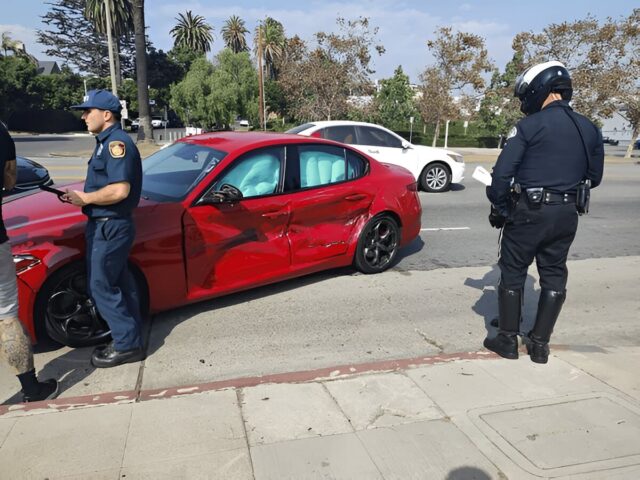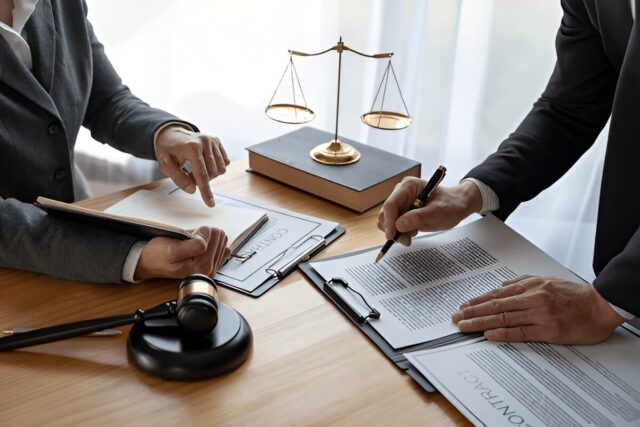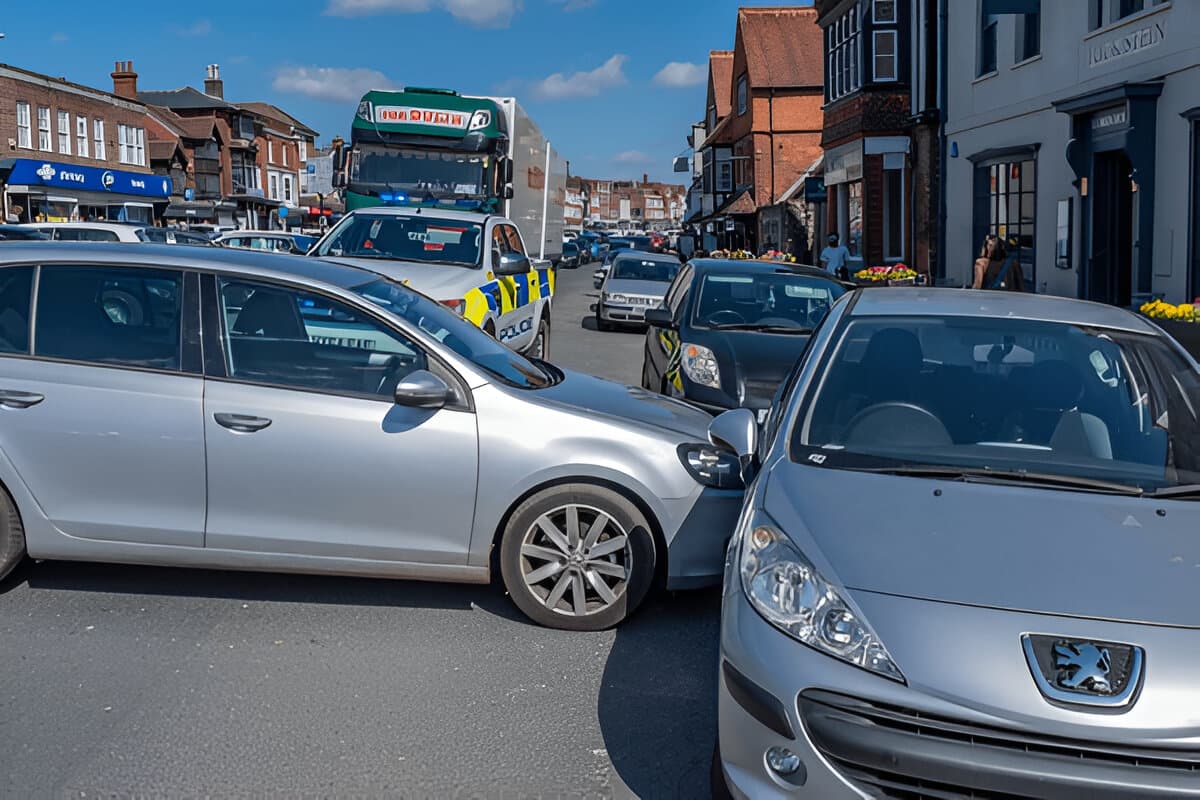When two cars smash together at an intersection, often called a “T-bone” crash, it seems like a no-brainer. One driver blew through a light or stop sign, the other had the green light—end of story, right?
Not so fast.
Unraveling who’s truly to blame in these chaotic moments, and who pays for the wreckage and injuries, is more challenging than it appears. In Arkansas, fault can be divided amongst multiple parties. As soon as the dust settles, insurance adjusters and opposing lawyers conduct their own investigations, looking for any reason to shift some or all of the blame onto someone else. To truly safeguard yourself, we need to look beyond who got a traffic ticket and explore the factors that determine fault.
If a devastating T-bone crash has left you or a loved one hurting in Arkansas, you don’t have to figure this all out alone. Our team of Arkansas car accident attorneys at Caddell Reynolds Law Firm deal with these complex scenarios every single day.
Call us at (479) 782-5297 for a free consultation today.
The Core Question: Who Had the Right-of-Way?
At the heart of any intersection accident case is a single, fundamental question: Who had the legal right to be where they were? The official rules of the road are the starting point for untangling what happened.
Traffic Signals and Signs
Disregarding a traffic signal is a primary cause of side-impact collisions. Arkansas law is explicit: a steady red light means a driver must stop before the crosswalk or intersection. A driver who runs a red light or a stop sign violates their most basic duty of care to others on the road.
However, fault is not always automatic. A driver who lawfully proceeds on a green light might still bear some responsibility if they were acting negligently. For instance, if the driver with the green light was speeding or looking at their phone instead of the road, their inattention could contribute to the crash. The law expects all drivers to remain aware of their surroundings, even when they have the right-of-way.
Left Turns
Left turns are a common point of conflict at intersections. The law generally requires that drivers intending to turn left must yield to oncoming traffic that is close enough to be an immediate hazard. Many T-bone accidents happen because the turning driver misjudges the speed or distance of an approaching vehicle.
These scenarios frequently dissolve into a “he said, he said” disagreement. The turning driver may claim the other car was speeding, while the oncoming driver insists the turn was made unsafely. Without objective evidence, proving what truly occurred becomes a significant challenge.
Four-Way Stops and Uncontrolled Intersections
Intersections without traffic signals are governed by specific right-of-way rules. At a four-way stop, the first vehicle to arrive and make a complete stop has the right to proceed first. If two vehicles arrive at the same time, the vehicle on the right has the right-of-way. The driver on the left must yield.
Disputes at these intersections are common, as it can be difficult to definitively establish who stopped first. Witness statements and physical evidence from the scene become incredibly important in reconstructing the sequence of events and proving who failed to yield.
How to Prove Fault
Insurance companies and lawyers build a case by meticulously gathering and analyzing every piece of available information.
The Official Story—The Police Report
 An officer responding to the scene will create a police report, which serves as the first official record of the accident. This report contains the officer’s observations, diagrams of the scene, statements from drivers and witnesses, and a notation of any traffic citations issued. It provides a valuable starting point for any investigation.
An officer responding to the scene will create a police report, which serves as the first official record of the accident. This report contains the officer’s observations, diagrams of the scene, statements from drivers and witnesses, and a notation of any traffic citations issued. It provides a valuable starting point for any investigation.
However, the police report is not the final word on fault. An officer’s conclusions are based on the limited information available at the scene. Under Arkansas rules of evidence, police reports are typically considered hearsay and may not be admissible as direct evidence in court. Our firm will conduct a deeper investigation to either substantiate the report’s findings or challenge them with more compelling evidence.
Telling the Story Through Physical Evidence
The cars and the roadway itself can provide a wealth of information. This is forensic science for a car crash, where a trained eye can interpret the physical aftermath to understand the forces at play.
- Vehicle Damage: The location, type, and severity of damage to each car can tell a story. An accident reconstructionist can analyze the crush damage to estimate the speed of impact, the angle of the collision, and how the vehicles moved in relation to one another.
- Skid Marks and Debris: The length and direction of skid marks on the pavement can reveal braking action (or a lack thereof) and vehicle speed. The location of shattered glass, broken parts, and fluid leaks creates a debris field that pinpoints the area of impact.
Video and Photographic Evidence
In many cases, the most objective and persuasive evidence comes from video footage or photographs. This type of evidence eliminates the unreliability of human memory and provides a clear, unbiased account of the incident.
- Traffic and Business Surveillance Cameras: Many intersections are monitored by municipal traffic cameras. Nearby businesses, such as banks, convenience stores, and gas stations, typically have their own security cameras that may have captured the accident from a different angle. We will promptly canvas the area to identify and secure this footage before it is overwritten.
- Dash Cams: The use of dash cams in personal and commercial vehicles is on the rise. If your vehicle, or even a witness’s vehicle, had a dash camera running, the footage might provide indisputable proof of what happened.
- Your Own Photos: Pictures taken at the scene are immensely valuable. Photos of the final resting positions of the vehicles, the damage to both cars, relevant traffic signs, and the overall road conditions can help preserve a snapshot of the scene long after the wreckage has been cleared.
Eyewitness and Expert Testimony
What people saw and what science can prove are both pillars of a strong case. We seek out credible voices to explain what happened and why.
- Eyewitnesses: An independent witness—someone who has no personal or financial stake in the outcome—could provide a powerful, credible account. Their neutral testimony about which driver had the red light or who failed to stop may corroborate our client’s version of events and refute the other driver’s claims.
- Expert Witnesses: In more complex T-bone cases, we may work with an accident reconstructionist. This is a professional who uses physics, engineering, and forensic mapping to analyze all the collected evidence—physical, digital, and testimonial—to form a scientific opinion on how and why the crash occurred.
Digital Clues
Modern vehicles are full of technology that records information, creating a digital trail that could uncover the truth.
- Event Data Recorders (EDR): Also called a vehicle’s “black box,” an Event Data Recorder is a device that captures and stores technical data in the seconds just before, during, and after a crash. This data can include vehicle speed, brake application, throttle position, steering inputs, and seatbelt usage. An EDR can definitively answer questions about whether a driver tried to brake or was accelerating at the moment of impact.
- Cell Phone Records: If there is reason to believe the other driver was distracted, cell phone records can become a key piece of evidence. Under Arkansas law, it is illegal to use a handheld phone to type or text while driving. Phone records show if the driver was texting, emailing, or otherwise using their device in the moments leading up to the collision.
What if You Are Partially to Blame? Arkansas’s Comparative Fault Law
You may worry that a small mistake on your part could prevent you from recovering anything for your injuries. In Arkansas, this is not necessarily the case.
An Explanation of Modified Comparative Fault
Arkansas operates under a legal rule called “modified comparative fault.” In simple terms, this doctrine allows you to recover damages even if you were partially to blame for an accident. The amount of compensation you can receive is simply reduced by your assigned percentage of fault.
For example, imagine you are awarded $100,000 for your injuries, but a jury determines that you were 20% at fault for the accident. Under the modified comparative fault rule, your award would be reduced by 20%, meaning you would be able to recover $80,000.
The 50% Bar Rule
Here is the most important part of the rule: you are barred from recovering any compensation if your share of the fault is determined to be 50% or greater. If you are found to be 49% at fault, you can still recover 51% of your damages. But if that share of fault tips to 50%, you recover nothing.
This 50% bar makes it extremely important to have a strong advocate on your side. Insurance companies for the other driver will try to shift as much blame as possible onto you to either reduce their payout or, ideally for them, eliminate it completely. Even a small, unsubstantiated allegation of fault against you has serious consequences, making the difference between a fair recovery and no recovery at all.
Protecting Your Rights After a T-Bone Accident (Now That You’re Home)
Once you have returned home and attended to your immediate medical needs, the focus shifts to preserving the strength of your potential legal claim.
Preserve All Documentation
Create a dedicated file, physical or digital, and keep everything related to the accident in one place. This includes the information you exchanged with the other driver, the police report number, photos you took at the scene, names and contact information for witnesses, and any letters or emails you receive from insurance companies.
Report the Accident (If Required)
Even if police responded to the scene, you may have your own reporting duty. Under Arkansas law, you are required to file your own accident report with the Office of Driver Services if the crash resulted in an injury, death, or apparent property damage of $1,000 or more and a police report was not filed. This must be done promptly.
Be Careful When Speaking to Insurance Adjusters
You can expect a call from the other driver’s insurance adjuster very soon after the accident. It is their job to gather information that helps their company minimize what it has to pay. They are trained to ask questions that might get you to downplay your injuries or inadvertently admit some level of fault.
- Instead of: Giving a recorded statement, guessing about details, or saying “I’m fine.”
- Try this: Provide only basic, factual information like your name and contact details. Politely decline to give a recorded statement until you have spoken with an attorney.
Keep Track of Your Injuries and Expenses
Attend all doctor’s appointments, follow treatment plans, and fill all prescriptions. This creates a clear medical record that documents the link between the accident and the injuries you sustained.
At the same time, keep a running list of all related expenses. This includes medical bills, co-pays, prescription receipts, and any out-of-pocket costs. You should also maintain a log of the days you missed from work and any resulting lost wages.
Be Mindful of the Deadline to File a Lawsuit
Every state has a time limit for filing a personal injury claim or lawsuit, known as the statute of limitations. In Arkansas, you generally have three years from the date of the accident to file a lawsuit. While three years may sound like a long time, it is never a good idea to wait. Building a strong case involves extensive investigation and evidence gathering, all of which takes time. Delaying can result in lost evidence and faded memories, potentially weakening your claim.
FAQ for T-Bone Accidents in Arkansas
What if the other driver was ticketed, but their insurance is still denying fault?
A traffic ticket is a useful piece of evidence, but it does not legally bind an insurance company in a civil claim. The insurance adjuster will perform their own fault investigation. If they believe they can build a case that you were partially responsible—perhaps by arguing you were speeding or not paying attention—they may dispute liability to reduce or deny your claim. This is a common tactic, and having a legal team to push back with evidence will help keep things fair.
What if there were no witnesses to the accident?
While independent witnesses are helpful, many successful cases are built without them. In a “he said, he said” situation, the focus shifts heavily to other forms of evidence. We would concentrate on a forensic analysis of the physical evidence, obtaining any available surveillance footage, and securing the digital data from both vehicles’ Event Data Recorders (EDRs) to reconstruct what happened.
Let Us Uncover the Story of Your Accident
 Determining fault after a T-bone collision is about finding the truth in the details, reconstructing the moments before impact using science, law, and diligent investigation. At Caddell Reynolds Law Firm, our Arkansas personal injury lawyers know where to look for that truth and how to build a case that tells the full story of what happened to you.
Determining fault after a T-bone collision is about finding the truth in the details, reconstructing the moments before impact using science, law, and diligent investigation. At Caddell Reynolds Law Firm, our Arkansas personal injury lawyers know where to look for that truth and how to build a case that tells the full story of what happened to you.
Let our team handle the legal complexities so you can dedicate your energy to healing. For a dedicated legal team that will pursue the compensation you need, contact Caddell Reynolds Law Firm today for a free evaluation of your case.
Call us at (479) 782-5297

